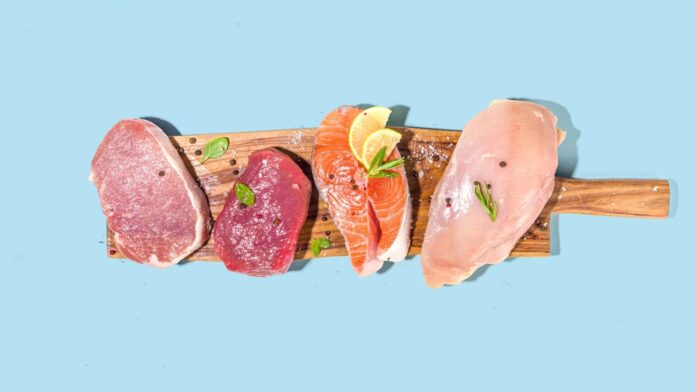Protein is fundamental for muscle growth, immune function, and overall health. While plant-based sources offer protein, animal meats generally provide a more complete amino acid profile and higher digestibility. Understanding which meats deliver the most protein per serving is crucial for optimizing your diet. This article breaks down protein content across common meats, explains individual needs, and offers practical guidelines for incorporating them into your meals.
Protein Content by Meat Type
Chicken breast leads in protein density, but most meats provide comparable amounts. Choosing lean cuts and trimming excess fat are key considerations. Here’s a detailed breakdown per 4oz serving:
- Chicken Breast (Skinless, Boneless): 25.4g
- Salmon (Sockeye): 25.2g
- Pork Chop (Loin): 24.4g
- Steak (Top Sirloin): 22.5g
- Ground Turkey (93% Lean): 22.3g
- Tuna (Light, Canned in Water): 22g
- Ground Beef (90% Lean): 21.9g
- Ham (Sliced, Cured): 18.6g
- Lamb (Loin Chop): 17.5g
- Bacon (Pork, Cured): 15.4g
How Much Protein Do You Need?
Protein requirements vary based on age, body weight, activity level, and health goals. The Recommended Dietary Allowance (RDA) for most adults is 0.8 grams per kilogram (0.36 grams per pound) of body weight. This is the minimum to prevent deficiency. More active individuals or those with specific health conditions may need more.
For example, a 150-pound person with moderate activity should aim for around 55 grams of protein daily. Prioritizing lean animal protein sources can help meet these needs efficiently.
Beyond Protein: Nutritional Considerations
While protein is central, consider the broader nutritional profile of each meat. Salmon, for example, provides essential omega-3 fatty acids. Red meats like beef offer iron and zinc. Processed meats like bacon are high in sodium and saturated fat, making them less desirable for regular consumption.
Making Informed Choices
To maximize benefits, experts recommend:
- Prioritize lean cuts: Trim visible fat before cooking.
- Vary protein sources: Include poultry, fish, and lean red meat in your rotation.
- Limit processed meats: Bacon, sausage, and deli meats should be occasional treats, not staples.
- Consider overall diet: Protein intake should be balanced with carbohydrates, fats, and micronutrients.
The Bottom Line
Protein is essential for health, and animal meats are an efficient source. Chicken breast, salmon, and lean beef stand out for their high protein content. By making informed choices and incorporating variety, you can optimize your protein intake for muscle growth, recovery, and overall well-being.
Ultimately, a balanced diet with adequate protein from high-quality sources is a cornerstone of a healthy lifestyle



































